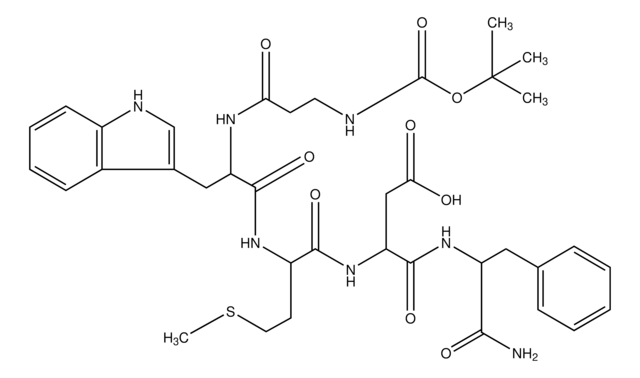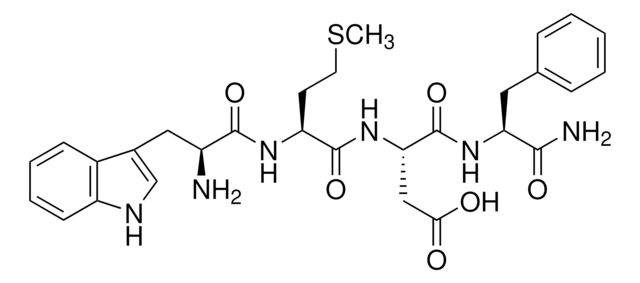B1636
Pentagastrin
≥95% (HPLC), powder, CCK2 receptor agonist
Synonym(s):
Peptavlon, Petogasrin, N-t-Boc-β-Ala-Trp-Met-Asp-Phe amide
About This Item
Recommended Products
Product Name
Pentagastrin, ≥95% (HPLC), powder
assay
≥95% (HPLC)
form
powder
storage condition
(Keep container tightly closed in a dry and well-ventilated place.)
color
white to off-white
solubility
DMF: 20 mg/mL, clear, colorless to faint yellow or tan
storage temp.
−20°C
SMILES string
CSCCC(NC(=O)C(Cc1c[nH]c2ccccc12)NC(=O)CCNC(=O)OC(C)(C)C)C(=O)NC(CC(O)=O)C(=O)NC(Cc3ccccc3)C(N)=O
InChI
1S/C37H49N7O9S/c1-37(2,3)53-36(52)39-16-14-30(45)41-28(19-23-21-40-25-13-9-8-12-24(23)25)34(50)42-26(15-17-54-4)33(49)44-29(20-31(46)47)35(51)43-27(32(38)48)18-22-10-6-5-7-11-22/h5-13,21,26-29,40H,14-20H2,1-4H3,(H2,38,48)(H,39,52)(H,41,45)(H,42,50)(H,43,51)(H,44,49)(H,46,47)
InChI key
NEYNJQRKHLUJRU-UHFFFAOYSA-N
Gene Information
mouse ... Cckbr(12426)
rat ... Cckar(24889) , Cckbr(25706)
Looking for similar products? Visit Product Comparison Guide
Amino Acid Sequence
General description
Application
Biochem/physiol Actions
antibody
inhibitor
Storage Class
11 - Combustible Solids
wgk_germany
WGK 3
flash_point_f
Not applicable
flash_point_c
Not applicable
Choose from one of the most recent versions:
Already Own This Product?
Find documentation for the products that you have recently purchased in the Document Library.
Our team of scientists has experience in all areas of research including Life Science, Material Science, Chemical Synthesis, Chromatography, Analytical and many others.
Contact Technical Service







